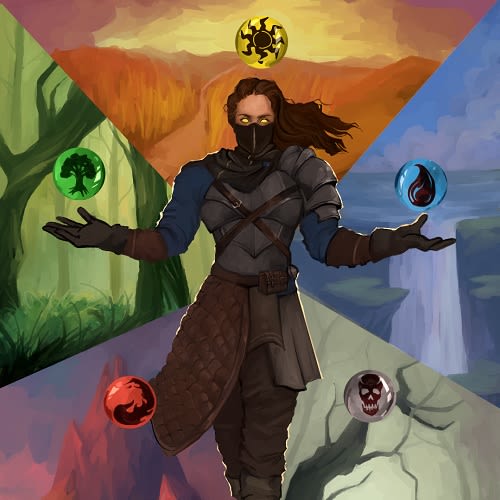I have a soft spot for Ravnica in my heart, because that is the first block that I really got into drafting heavily. I still regard Ravnica–Guildpact–Dissension as the best Draft format ever. Ravnica introduced a lot of new mechanics and abilities, each guild had its own feel, and there were ten guilds all together. Let’s get to the nitty-gritty!
Ravnica
Hybrid Mana
This was the first set to introduce the mana symbols that were half one color and half another color. These function just like regular mana symbols, except that you can pay hybrid mana with 1 mana of either color in the hybrid symbol. For instance, ![]() can be paid with either
can be paid with either ![]() or
or ![]() . Spells with hybrid mana costs are also the colors of both halves of its hybrid mana symbols. You choose which half of a hybrid mana symbol you are going to pay in Step 2 of casting a spell, which is the “choose modes” step.
. Spells with hybrid mana costs are also the colors of both halves of its hybrid mana symbols. You choose which half of a hybrid mana symbol you are going to pay in Step 2 of casting a spell, which is the “choose modes” step.
Convoke
This is the mechanic for the Selesnya guild, which was the G/W guild. Basically, this mechanic lets you tap creatures to reduce the cost of the Convoke spell. It’s kind of flavored to make those creatures act like lands during the casting of the spell. Popular Convoke cards are Scatter the Seeds and Chord of Calling. The creatures will reduce the cost of the Convoke spell by either 1 colorless mana or by 1 colored mana of a color shared by both the spell and the creature being tapped. Convoke is technically an “additional cost,” and tapping the creatures happens in the “pay costs” step, which is Step 7 of casting a spell. Here’s a popular judge question regarding Convoke:
Q: Player A controls Wild Cantor and wants to cast Chord of Calling with ![]() = 2. He chooses to tap the Wild Cantor for Convoke and also to sacrifice it for mana to help pay for Chord of Calling. Is this legal?
= 2. He chooses to tap the Wild Cantor for Convoke and also to sacrifice it for mana to help pay for Chord of Calling. Is this legal?
A: Nope! Since tapping the Wild Cantor would happen in Step 7, and Wild Cantor needs to be sacrificed for mana in Step 6, it won’t be around to tap for Convoke!
Dredge
Here’s a mechanic that really has made a big splash in every format that it has been legal in, reaching all the way back to Vintage. This is the mechanic of the Golgari guild, which was the B/G guild. Dredge is written as “Dredge X,” where every time you would draw a card, you can choose instead to put the top X cards of your library into your graveyard and place the card with Dredge into your hand from your graveyard. Popular Dredge cards are Stinkweed Imp and Golgari Grave-Troll. The Dredge deck functions by using cards with high Dredge values and cheap card-draw spells to dump a ton of cards into the graveyard. In this way, you set up a perfect storm of Flashback spells to win in one turn, usually by reanimating Iona or Flame-Kin Zealot to pump all of your tokens from Bridge from Below.
One thing to note with Dredge is that you can replace any draw with Dredge, not just your main draw for the turn. Also, once you decide to dredge, your opponent cannot remove the Dredge card in response since it’s a replacement effect, and those don’t use the stack. Finally, if you have fewer cards in your library than the Dredge value of your spell, you cannot dredge the spell back into your hand.
Transmute
This is the mechanic of the Dimir guild, which was the U/B guild. This mechanic has also found a lot of purchase in certain decks—usually those based on getting certain lands into play. The card that players use for this is Tolaria West. Transmute lets you pay a cost and discard the card with Transmute to search your library for another card with a converted mana cost equal to the card you transmuted. One thing to note about Transmute is that it only cares about converted mana cost, so you can transmute a spell that costs ![]()
![]() into a spell that costs
into a spell that costs ![]()
![]() . You don’t have to find a card in your library—you can activate Transmute just to look through your library and shuffle it. Finally, Transmute can only be activated at sorcery speed, which means during your turn, in one of your main phases, and with the stack empty.
. You don’t have to find a card in your library—you can activate Transmute just to look through your library and shuffle it. Finally, Transmute can only be activated at sorcery speed, which means during your turn, in one of your main phases, and with the stack empty.
Radiance
Radiance is the mechanic of the Boros guild, which was the R/W guild. This ability word let you distribute the effects of a spell among all creatures that shared a color with the initially targeted creature. A good example of a Radiance card would be Cleansing Beam. This card deals 2 damage to target creature and each other creature that shares a color with the target creature. An important note for this mechanic is that colorless creatures don’t share a color with other colorless creatures, since colorless isn’t a color. Also, the Radiance spell also only has one target, so if that target becomes illegal before the spell resolves, the effects do not happen to the other creatures that share a color with the initial target—the spell becomes countered upon resolution.
Shock Lands
Ravnica also introduced a new type of dual land, commonly referred to as the “shock lands.” These lands have two basic land types, just like the old dual lands (e.g., Taiga). This means that all of the tricks that you can do with those old dual lands you can also do with these new ones. For instance, you can fetch a Watery Grave with a Bloodstained Mire. Anything that refers to a basic land type (e.g., Forest) will be able to use any of the shock lands with the Forest subtype. These lands come into play tapped unless you pay 2 life, hence the “shock” in “shock land”. If you pay the life, the lands come into play untapped and ready to rock! An important note here is that even though the lands have two basic land types, they are nonbasic lands and will be affected by anything that cares about nonbasic lands, such as Blood Moon.
Guildpact
Bloodthirst
This is the mechanic of the Gruul guild, which was the R/G guild. This mechanic should be familiar to any of you who play Standard, as they brought it back in M12. Some example cards are Blood Ogre and Gristleback. The way that Bloodthirst works is that you’ll have a creature with Bloodthirst X, and if an opponent has been dealt damage this turn, the creature with Bloodthirst will enter the battlefield with X +1/+1 counters on it (i.e., a 2/2 with Bloodthirst 2 will enter the battlefield as a 2/2 with 2 +1/+1 counters on it if your opponent has been dealt damage previously in that turn). An important rules note here is that multiple instances of Bloodthirst will stack favorably. Also, the creature with Bloodthirst enters the battlefield with those counters, so the 2/2 with Bloodthirst 2 will enter as a 4/4 creature and never exist on the battlefield as a 2/2 without counters on it.
Haunt
Haunt is the mechanic of the Orzhov guild, which was the W/B guild. This mechanic allowed you to get double value from your spells in a unique way. When a card with Haunt goes to the graveyard, you exile it “haunting” target creature. When that “haunted” creature dies, you get the effect of the Haunt spell again. Popular Haunt cards are Cry of Contrition and Blind Hunter. An important note on Haunt is that if you have an instant or sorcery with Haunt and it is countered, the Haunt effect won’t happen. Also, you can haunt any creature in play, and you can haunt the same creature with multiple cards. Finally, if there are no legal targets for Haunt, the Haunt card stays in the graveyard instead of being exiled.
Replicate
Replicate is the mechanic of the Izzet guild, which was the U/R guild. This mechanic triggers when a spell is cast, and it copies the spell for each time that the Replicate cost was paid. When you cast a spell with Replicate, you decide how many times you are going to pay the Replicate cost. You then pay for it in Step 7 of casting a spell. After Step 7, Replicate will trigger and copy the initial spell for each time you paid the Replicate cost. You can choose new targets for the copies. Once the copies are added to the stack, they exist as separate objects—countering one will not counter all of them. You can, however, counter the Replicate trigger much like you can counter a Storm trigger in order to stop any copies from being made. The most popular Replicate card is Shattering Spree, which finds its way into sideboards in various formats.
Dissension
Forecast
Forecast is the mechanic of the Azorius Guild, which was the W/U guild. This mechanic allowed you to pay a cost and reveal a card with Forecast from your hand during your upkeep in order to get an effect. The neat thing about this mechanic is that it let you reuse an effect over and over again without having to actually cast the card. The most famous Forecast card that made it into a lot of decks—even Modern deck lists—is Proclamation of Rebirth. An important note with Forecast is that once you reveal the card in your upkeep, it stays revealed for the duration of the upkeep. This prevents you from using the same card to forecast more than once per upkeep.
Graft
Graft is the mechanic of the Simic guild, which was the G/U guild. This mechanic has creatures entering the battlefield with X +1/+1 counters, and then whenever another creature enters the battlefield, you may move one of the +1/+1 counters to that creature. Most of the creatures with Graft would also have abilities that interacted with creatures that had +1/+1 counters on them. Some notables are Plaxcaster Frogling and Experiment Kraj. An important notes is that Graft will trigger whenever any creature enters the battlefield, so you can put +1/+1 counters on your opponents’ creatures. Also, Graft doesn’t target, so you can move a +1/+1 counter onto a creature with Shroud. Finally, if you have two creatures enter the battlefield at the same time, and one of them has Graft, it will be able to see the other creature and move a counter onto it.
Hellbent
Hellbent is the mechanic of the Rakdos guild, which was the B/R guild. This mechanic was pretty simple. Essentially, you would have a spell that had a better effect if you had no cards in your hand. Some permanents had Hellbent, which meant that as long as you had no cards in hand, the permanent would get some kind of bonus. Instants and sorceries also had Hellbent, which means that they checked whether you had cards in your hand upon resolution of the spell. If the Hellbent ability granted an activated ability to a permanent, the number of cards in hand was checked when you activated the ability, not when it resolved. Demonfire is the most famous Hellbent card.
Ravnica was a great block and chock-full of new mechanics—some have found their way into Modern and a lot are used in Commander and other casual variants. As always, post any questions or comments in the section below, and I’ll answer them for you as soon as I can. I usually check the comments every few days. Stay tuned for next week, when we get into Time Spiral!
























